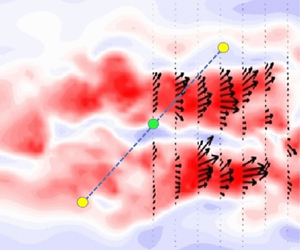Article contents
Analysis of interscale energy transfer in a boundary layer undergoing bypass transition
Published online by Cambridge University Press: 25 April 2022
Abstract

The Kármán–Howarth–Monin–Hill equation is employed to study the production and interscale energy transfer in a boundary layer undergoing bypass transition due to free-stream turbulence. The energy flux between different length scales is calculated at several streamwise locations covering the laminar, transitional and turbulent regimes. Maps of scale energy production and flux vectors are visualised on two-dimensional planes and three-dimensional hyper-planes that comprise both physical and separation spaces. In the transitional region, the maps show strong inverse cascade in the streamwise direction near the wall. The energy flux vectors emanate from a region of strong production and transfer energy to larger streamwise scales. To provide deeper insight into the origin of the inverse cascade process, we decompose the energy flux vector into components arising from nonlinear interactions between velocity fluctuations, mean flow inhomogeneity, pressure and viscous effects. The inverse cascade is mainly due to the nonlinear interaction component, and in the earliest stages of transition this component competes with that due to mean flow inhomogeneity. By superposing the instantaneous velocity fields and the energy flux vectors, we relate the inverse cascade process to the growth of turbulent spots. Once the transition process is complete, the maps become very similar to those observed in other fully developed turbulent flows, such as channel flow. Finally we characterise the nonlinear interaction term using probability density functions (PDFs) evaluated at different wall-normal heights. The PDFs are asymmetric and wide-skirted as in homogeneous isotropic turbulence, but are skewed towards positive values reflecting the inverse cascade.
- Type
- JFM Papers
- Information
- Copyright
- © The Author(s), 2022. Published by Cambridge University Press
References
REFERENCES
- 10
- Cited by





